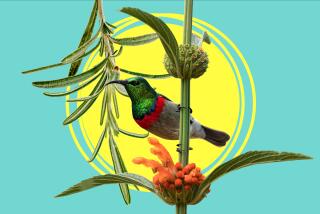Gardening
- Share via
Atriplex canescens Saltbush
Evergreen shrub with silver-gray leaves
The common name is a definite clue here; atriplex thrives in alkaline desert soils or blasts of salty sea air. Native to the West, the saltbush has survived on a very low-water diet and is well-adapted to the fire-prone chaparral climate. It will burn, but it springs right back after a fire. A very fast grower, its roots sprawl almost as much as do the branches, so it is also a fine plant for erosion control on hillsides.
These all are very desirable habits in these days of meager water and Santa Ana flameouts, but atriplex has one more very important characteristic: It’s strikingly handsome. The leaves are shimmery silver in twilight, dazzling near-white in sun; they bring out the best in bright pink geraniums planted nearby, and they’re a perfect contrast to Dodonaea viscosa’s mahogany leaves.
Some atriplexes are low and tidy ( semibaccata is a ground cover); Atriplex hymenelytra has hollylike leaves and keeps itself to a trim, tight 3-foot bush, but A. canescens stretches out to 8 feet in all directions, easily overwhelming anything in its path (keep the pink geraniums at a safe distance). I planted an Atriplex halimus-- grown from a cutting--in my front yard thinking that it would grow up to look like a cute little santolina. A few months later I had to machete it back to a manageable 6 feet and lost a few pink geraniums in the process.
After a year of major surgeries, I had to (reluctantly) remove the atriplex. The moral of this tale: Put atriplex halimus or canescens where it belongs--in a nice, wide-open space.
You probably won’t find many atriplexes in urban nurseries, but they are worth a diligent search. Desert-community nurseries would be a better bet, but, if that isn’t practical, ask your nurseryman to order from the wholesale-only Monterey Bay Nursery in Watsonville, which grows Atriplex lentiformis breweri and A. semibaccata (the lentiformis, by the way, is the one most recommended for stabilizing slopes).






